“The battle is glorious, higher than Chesma and Navarino!”
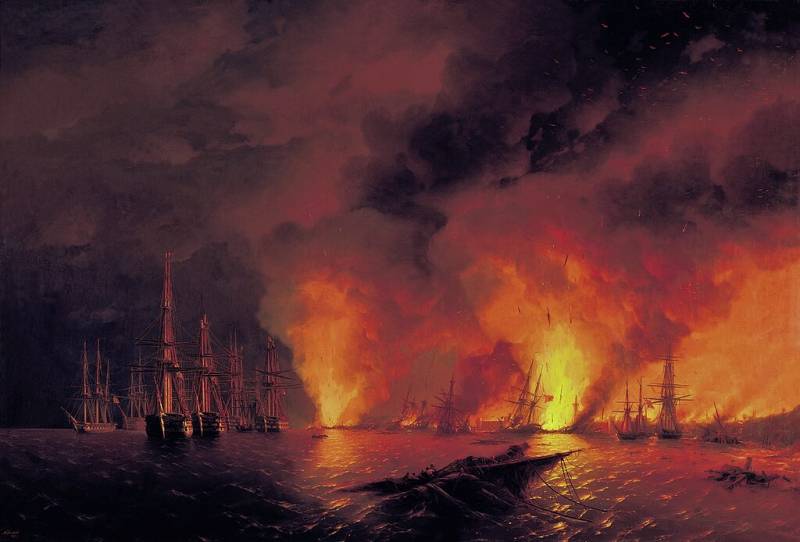
I.K. Aivazovsky. “Battle of Sinop November 18, 1853 (Night after the battle)”
prehistory
In 1853, another Russian-Turkish war began (How Türkiye opposed the “gendarme of Europe”). Fronts were opened on the Danube and the Caucasus. St. Petersburg was counting on a quick victory over Turkey, whose military potential had noticeably degraded. The Russian army and navy could already take Constantinople in 1829 (Constantinople at the feet of the Russian Tsar), but the tsarist government did not dare to take such a daring step.
In 1853, England and France were ready to support Turkey in order to crush the “gendarme of Europe.” That’s what they called the Russian Empire back then, which after the victory over Napoleon’s empire was considered the strongest military power. The Anglo-French squadron entered the Dardanelles.
St. Petersburg, which was counting on a quick victory over the Porte, a decisive advancement of Russian interests in the Balkans and a successful solution to the problem of the Bosphorus and Dardanelles, received the threat of war with the great powers with vague prospects. There was a danger that the Ottomans, followed by the British and French, would be able to provide effective assistance to the Shamil mountaineers. This led to a new large-scale war in the Caucasus and serious tension in Russia from the south.
Since the beginning of hostilities, the Turks have sharply increased supplies weapons mountain tribes of the Caucasus who fought with the Russians. To cover communications with the Caucasian coast and a possible landing, the Sultan sent Osman Pasha's squadron to Sinop. A 20-strong Turkish corps was concentrated in Batumi, which was supposed to be transferred by a large transport flotilla (up to 250 vessels). The landing was to be covered by Osman Pasha's squadron.
The Black Sea Fleet under the command of Pavel Stepanovich Nakhimov was supposed to interfere with the enemy. From the end of October 1853, Nakhimov and his detachment cruised between Sukhum and the coast of Anatolia, where the main port was Sinop.
On November 11, Nakhimov approached Sinop, where he discovered the enemy. The admiral blocked the bay and began to wait for reinforcements (some of the ships of the squadron were sent to Sevastopol for repairs). The Turkish command, although at that time had an advantage in strength, did not dare to engage in a general battle or simply make a breakthrough. Meanwhile, Menshikov sent reinforcements - Novosilsky's squadron, and then a detachment of Kornilov's steamers.
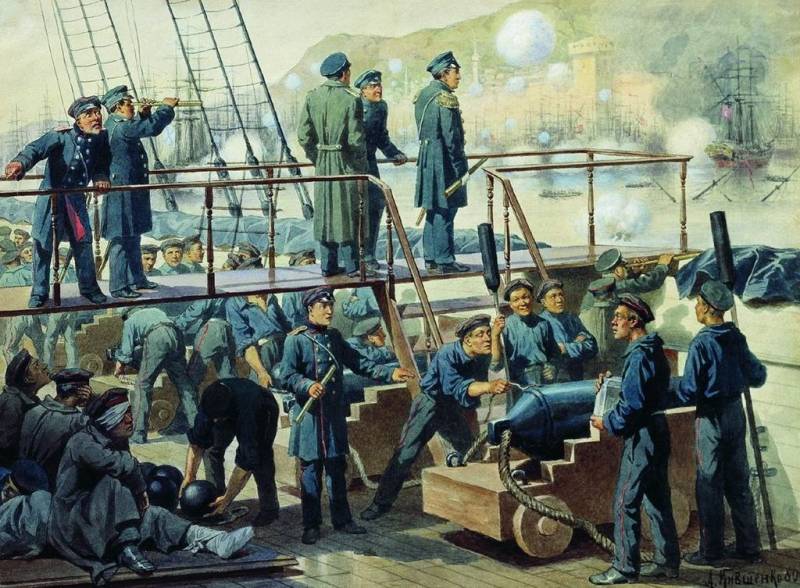
The deck of the battleship "Empress Maria" during the battle of Sinope. 1853 Hood. Alexey Kivshenko. 1880, Central Naval Museum
The forces of the parties
On November 16 (28), 1853, Nakhimov’s detachment was reinforced by the squadron of Rear Admiral Fyodor Novosilsky: 120-gun battleships “Paris”, “Grand Duke Konstantin” and “Three Saints”, frigates “Kahul” and “Kulevchi”. As a result, under the command of Nakhimov there were 6 battleships: the 84-gun Empress Maria, Chesma and Rostislav, the 120-gun Paris, Grand Duke Konstantin and Three Saints, the 60-gun frigate Kulevchi "and 44-gun "Kahul".
Nakhimov had 716 guns; from each side the squadron could fire a salvo weighing 378 pounds 13 pounds. 76 guns were bomb guns, firing explosive bombs that had great destructive power. As a result, the Russian fleet had an advantage in strength. Kornilov also rushed to Nakhimov’s aid with three steam frigates.
The Turkish squadron consisted of 7 frigates, 3 corvettes, several auxiliary ships and a detachment of 3 steam frigates. In total, the Turks had 476 naval guns, supported by 44 coastal guns. The Ottoman squadron was led by the Turkish Vice Admiral Osman Pasha. The second flagship was Rear Admiral Hussein Pasha. There was an English adviser with the squadron - Captain A. Slade. The steamship detachment was commanded by Vice Admiral Mustafa Pasha.
The Turks had their advantages, the main ones being parking in a fortified base, support for coastal batteries and the presence of steamships, while the Russians only had sailing ships. The Ottomans also notified Constantinople about the appearance of the Russian fleet and waited for help.
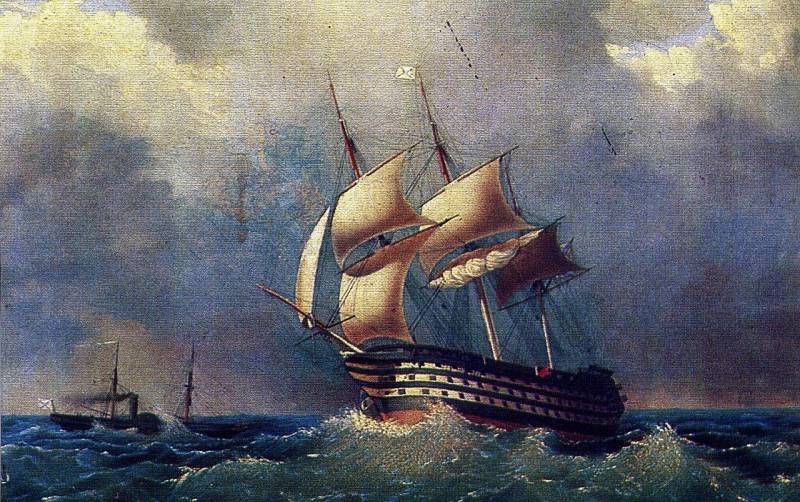
I. K. Aivazovsky “120-gun ship “Paris”
Battle
Nakhimov decided to enter the bay and attack the enemy. The Turks, fearing the Russians, positioned the ships in a concave arc, clinging to the shore. As a result, the Turkish squadron partially blocked the firing sector of coastal batteries, and the Ottoman ships also lost the ability to maneuver and fire on both sides.
The Russian squadron, in the formation of two wake columns (the ships followed one another along the course line), was supposed to break through to the Sinop roadstead and deliver a fire strike on the enemy ships and batteries. The first column was commanded by Nakhimov. It included the ships “Empress Maria” (flagship), “Grand Duke Konstantin” and “Chesma”. The second column was led by Novosilsky. It included “Paris” (2nd flagship), “Three Saints” and “Rostislav”. In the rearguard were frigates, which were supposed to stop the enemy’s attempts to escape.
At dawn on November 18 (30), Russian ships entered Sinop Bay. At 12:30 p.m., the Ottoman flagship, the 44-gun Avni-Allah, opened fire, followed by guns from other ships and coastal batteries. The Turkish command hoped that strong barrage fire from naval and coastal batteries would not allow the Russian squadron to break through at close range and would force the Russians to retreat.
Nakhimov's ship went ahead and stood closest to the Ottoman ships. The admiral stood on the captain's cabin and watched the fierce artillery battle unfold. Russian ships anchored 320–380 meters from the enemy ships and opened fire.
The victory of the Russian fleet became evident in just over two hours. Turkish artillery showered shells on the Russian squadron and was able to cause significant damage to some ships, but failed to sink a single one.
Nakhimov, knowing the techniques of the Ottoman commanders, foresaw that the main enemy fire would initially be concentrated on the mast (above-deck parts of the ship's equipment), and not on the decks. The Turks wanted to incapacitate as many Russian sailors as possible when they removed the sails before anchoring the ships, as well as disrupt the controllability of the ships and worsen their ability to maneuver.
And so it happened, Turkish shells broke the yards, topmasts, and made holes in the sails. The Russian flagship took on a significant part of the enemy attack, most of its spar and standing rigging were broken, only one shroud of the mainmast remained intact. After the battle, 60 holes were counted in one side. But the Russian sailors were below, Pavel Stepanovich ordered the ships to be anchored without removing the sails.
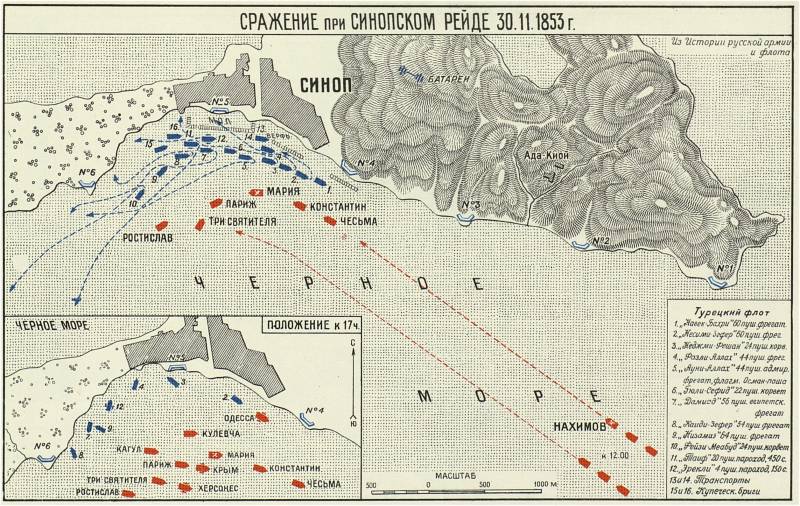
Battle of the Sinop raid on November 30.11.1853, XNUMX. Source: L. G. Beskrovny. Atlas of maps and diagrams of the Russian military stories
After just half an hour of battle, the Turkish admiral ordered the anchor chains to be riveted, and the Ottoman flagship Avni-Allah (Aunni-Allah) washed ashore. The team fled. Then the Russian flagship attacked the 44-gun frigate Fazli-Allah, which also could not withstand the duel and ran ashore. The admiral transferred the ship's fire to battery No. 5.
By 16 o'clock the battle was over. The ship "Grand Duke Konstantin" fired at the 60-gun frigates "Navek-Bahri" and "Nesimi-Zefer", the 24-gun corvette "Nedzhmi Fishan", at battery No. 4. "Navek-Bahri" took off after 20 minutes. One of the Russian shells hit the powder magazine. This explosion also disabled battery No. 4. Corpses and wreckage of the ship cluttered the battery. Later the battery resumed fire, but it was weaker than before. The second frigate, after its anchor chain was broken, washed ashore. The Turkish corvette could not stand the duel and ran ashore. “Grand Duke Constantine” received 30 holes and damage to all masts in the Battle of Sinop.
The ship "Chesma", under the command of Viktor Mikryukov, fired at batteries No. 4 and 3. Russian sailors strictly followed Nakhimov's instructions about mutual support. The ship "Konstantin" was forced to fight three enemy ships and a Turkish battery at once. Therefore, the Chesma stopped firing at the batteries and concentrated all its fire on the Turkish frigate Navek-Bahri. The Turkish ship, hit by fire from two Russian ships, took off into the air. Then "Chesma" suppressed the enemy batteries. The ship received 20 holes, damage to the mainmast and bowsprit.
The ship “Three Saints” under the command of K. S. Kutrov fought with the 54-gun frigate “Kaidi-Zefer” and the 62-gun “Nizamiye”. Enemy shots broke the spring of the Russian ship (the cable to the anchor holding the ship in a given position), and the “Three Saints” began to turn into the wind with its stern towards the enemy. The ship was subjected to longitudinal fire from battery No. 6, and its mast was seriously damaged. When midshipman Varnitsky was able to repair the damage on the Svyatitel, the ship began to successfully fire at the Kaidi-Zefer and other ships, forcing them to run ashore. "Three Saints" received 48 holes, as well as damage to the stern, all masts and bowsprit.
"Rostislav", under the command of Captain 1st Rank A.D. Kuznetsov, who himself was under heavy fire, stopped returning fire and focused all his attention on battery No. 6. As a result, the Turkish battery was razed to the ground. The Rostislav also forced the 24-gun corvette Feyze-Meabud to beach itself. “Rostislav” himself almost died. A fire started on it, the fire was approaching the crew chamber, but the fire was extinguished. "Rostislav" received 25 holes, as well as damage to all masts and bowsprit. More than 100 people from his team were wounded.
The second Russian flagship "Paris" fought an artillery duel with the 56-gun frigate "Damiad", the 22-gun corvette "Gyuli Sefid" and the central coastal battery No. 5. The corvette caught fire and took off into the air. The Russian ship concentrated fire on the frigate. The Damiad could not withstand the heavy fire, the Turkish crew cut off the anchor rope, and the frigate was thrown ashore.
Then the Paris attacked the 62-gun Nizamiye, on which Admiral Hussein Pasha was holding the flag. The Ottoman ship lost two masts - the foremast and the mizzen mast, and a fire started on it. The Nizamiye washed ashore. After the defeat of Nizamiye, Paris concentrated on the central coastal battery, which provided great opposition to the Russian squadron. The Turkish battery was suppressed. The ship received 16 holes, as well as damage to the stern and gondeck.
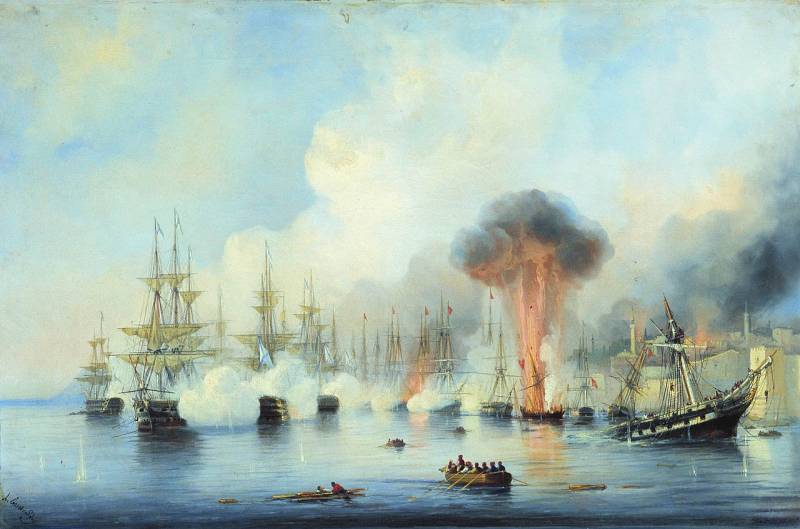
A. P. Bogolyubov. Battle of Sinop November 18, 1853
Complete victory
By 17:15, Russian sailors destroyed 16 of the XNUMX enemy ships with artillery fire and suppressed all of their coastal batteries. Random cannonballs also set fire to city buildings located in close proximity to the coastal batteries, which led to the spread of fire in Sinop.
Of the entire Turkish squadron, only one high-speed 20 cannon steamer Tayf (Taif) escaped with flight, carrying the chief seaman’s advisor on maritime affairs, Englishman Slade, who, arriving in Istanbul, reported on the extermination of Turkish ships in Sinop.
Russian frigates chased the ship, but could not catch up. A few miles from Sinop, the Taif met Kornilov's steamships - Odessa, Crimea and Khersones, which were going to help Nakhimov. Slade managed to squeeze 10 knots out of the car, while the Russian steam frigates could not give more than 8,5 knots. The Turkish ship has left.
By 18 p.m., Kornilov’s detachment arrived in Sinop Bay. He tried to find at least one ship that could be towed to Sevastopol as a prize. The frigate "Damiad", stranded near battery No. 6, seemed more or less intact. The steamer "Odessa" refloated the "Damiad", but an inspection showed that the ship was badly damaged by artillery fire, and its towing was impossible. The next day the frigate was burned.
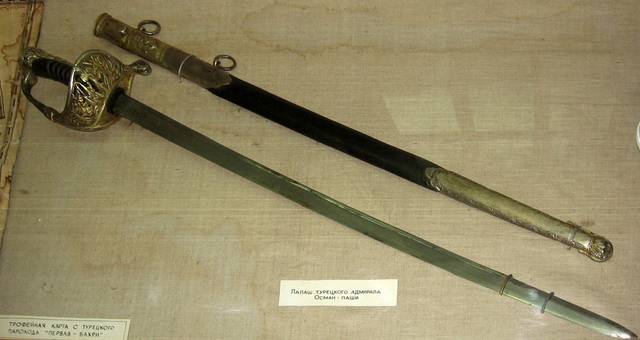
Broadsword of the commander of the Turkish squadron Osman Pasha, which he gave to the winners (Museum of the Russian Black Sea Fleet in Sevastopol)
“The battle is glorious, higher than Chesma and Navarino!” – this is how Vice Admiral V.A. Kornilov assessed the battle. The Turks lost the entire squadron, except for one steamer, about 3 thousand people, the British reported 4 thousand. Just before the battle, the Ottomans prepared for boardings and put additional soldiers on the ships.
Explosions at batteries, fires and explosions of beached ships led to a strong fire in the city. Sinop suffered greatly. The population, authorities and garrison of Sinop fled to the mountains. The British later accused the Russians of deliberate cruelty towards the townspeople. 200 people were captured by the Russians. Among the prisoners was the commander of the Turkish squadron, Vice Admiral Osman Pasha (his leg was broken in the battle) and two ship commanders.
With the defeat of Osman Pasha's squadron, the Turkish Navy was significantly weakened. Fifteen ships, which had been built and armed for many years before the war, were lost. Having lost 15 guns in the battle, the Turks lost almost a third of the entire artillery of their fleet. The Anglo-Turkish command for a long time lost the opportunity to use its main base on the Anatolian coast - Sinop.
A very significant loss for the Turkish fleet in the Battle of Sinop was the loss of personnel. The Turkish navy had always suffered from a severe shortage of trained personnel, and short-staffing of many ships was common. The loss of 3 thousand sailors was a disaster for the Turkish fleet. There were no reserves. Additional mobilization could not give anything. These losses were irreparable.
Some Russian ships received significant damage, they were then towed by steamers, but all remained afloat. Russian losses amounted to 37 killed and 233 wounded.
Russian ships fired about 17 thousand shells in four hours. The Battle of Sinop showed the importance of bombing guns for the future development of the fleet. Wooden ships could not withstand the fire of such cannons. It was necessary to develop armor protection for ships. The Rostislav gunners showed the highest rate of fire. 75–100 rounds were fired from each gun on the operational side of the battleship. On other ships of the squadron, 30–70 shots were fired from each gun on the active side.
Russian commanders and sailors, according to Nakhimov, showed “truly Russian courage.” The advanced system of educating the Russian sailor, developed and implemented by Lazarev and Nakhimov, proved its superiority in battle. Hard training and sea voyages led to the fact that the Black Sea Fleet passed the Sinop exam with flying colors.
The absence of dead ships and relatively low losses in manpower confirm the reasonableness of Nakhimov’s decisions and naval leadership. Nakhimov himself was, as always, modest and said that all the credit belongs to Mikhail Lazarev. The Sinop battle became a brilliant point in the long history of the development of the sailing fleet. It should be noted that Lazarev, Nakhimov and Kornilov understood this very well, being supporters of the rapid development of the steam fleet.
At the end of the battle, the ships carried out the necessary repairs and weighed anchor on November 20 (December 2), moving to Sevastopol. December 22 (December 4) The Russian fleet entered the Sevastopol roadstead with general jubilation. The entire population of Sevastopol greeted the victorious squadron. It was a great day. Endless “Hurray, Nakhimov!” rushed from all sides. News of the crushing victory of the Black Sea Fleet rushed to the Caucasus, the Danube, Moscow and St. Petersburg. Emperor Nicholas awarded Nakhimov the Order of St. George, 2nd degree.
The Battle of Sinop caused panic in Constantinople, where they were afraid of the appearance of the Russian fleet near the Ottoman capital. In Europe they were shocked that the Russians crushed the main forces of the Turkish fleet with one blow. The English and French squadrons, which were already stationed in the Bosphorus, on December 3 sent 2 ships to Sinop and 2 to Varna for reconnaissance.
Paris and London immediately gave Turkey credit for the war. The Turks had been asking for money for a long time without success. France and England were preparing to go to war. On the night of December 21–22, 1853 (January 3–4, 1854), the English and French squadrons, together with a division of the Ottoman fleet, entered the Black Sea.
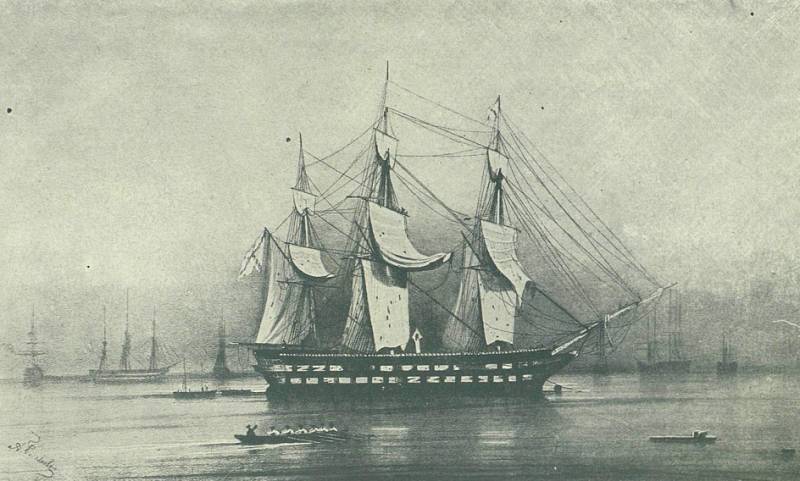
The ship "Empress Maria" under the flag of P. S. Nakhimov after the victory in the Battle of Sinop. Album “Russian Navy”, 1904
Information